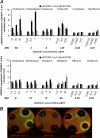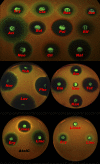Attenuation-based dual-fluorescent-protein reporter for screening translation inhibitors
- PMID: 22252829
- PMCID: PMC3318315
- DOI: 10.1128/AAC.05395-11
Attenuation-based dual-fluorescent-protein reporter for screening translation inhibitors
Abstract
A reporter construct was created on the basis of the transcription attenuator region of the Escherichia coli tryptophan operon. Dual-fluorescent-protein genes for red fluorescent protein and cerulean fluorescent protein were used as a sensor and internal control of gene expression. The sequence of the attenuator was modified to avoid tryptophan sensitivity while preserving sensitivity to ribosome stalling. Antimicrobial compounds which cause translation arrest at the stage of elongation induce the reporter both in liquid culture and on an agar plate. This reporter could be used for high-throughput screening of translation inhibitors.
Figures







Similar articles
-
Sorting Out Antibiotics' Mechanisms of Action: a Double Fluorescent Protein Reporter for High-Throughput Screening of Ribosome and DNA Biosynthesis Inhibitors.Antimicrob Agents Chemother. 2016 Nov 21;60(12):7481-7489. doi: 10.1128/AAC.02117-16. Print 2016 Dec. Antimicrob Agents Chemother. 2016. PMID: 27736765 Free PMC article.
-
The Tryptophan-Induced tnaC Ribosome Stalling Sequence Exposes High Amino Acid Cross-Talk That Can Be Mitigated by Removal of NusB for Higher Orthogonality.ACS Synth Biol. 2021 May 21;10(5):1024-1038. doi: 10.1021/acssynbio.0c00547. Epub 2021 Apr 9. ACS Synth Biol. 2021. PMID: 33835775
-
Modified nucleotides m(2)G966/m(5)C967 of Escherichia coli 16S rRNA are required for attenuation of tryptophan operon.Sci Rep. 2013 Nov 18;3:3236. doi: 10.1038/srep03236. Sci Rep. 2013. PMID: 24241179 Free PMC article.
-
[Correlation of transcription and translation in the tryptophan operon of Escherichia coli (author's transl)].Tanpakushitsu Kakusan Koso. 1973 Sep;18(9):833-42. Tanpakushitsu Kakusan Koso. 1973. PMID: 4582341 Review. Japanese. No abstract available.
-
Some novel transcription attenuation mechanisms used by bacteria.Biochimie. 1996;78(11-12):1017-24. doi: 10.1016/s0300-9084(97)86725-9. Biochimie. 1996. PMID: 9150880 Review.
Cited by
-
Mechanism-Based Approach to New Antibiotic Producers Screening among Actinomycetes in the Course of the Citizen Science Project.Antibiotics (Basel). 2022 Sep 5;11(9):1198. doi: 10.3390/antibiotics11091198. Antibiotics (Basel). 2022. PMID: 36139977 Free PMC article.
-
A bacterial regulatory uORF senses multiple classes of ribosome-targeting antibiotics.Elife. 2025 May 29;13:RP101217. doi: 10.7554/eLife.101217. Elife. 2025. PMID: 40439554 Free PMC article.
-
Comparison of mRNA features affecting translation initiation and reinitiation.Nucleic Acids Res. 2013 Jan 7;41(1):474-86. doi: 10.1093/nar/gks989. Epub 2012 Oct 23. Nucleic Acids Res. 2013. PMID: 23093605 Free PMC article.
-
Influence of the spacer region between the Shine-Dalgarno box and the start codon for fine-tuning of the translation efficiency in Escherichia coli.Microb Biotechnol. 2020 Jul;13(4):1254-1261. doi: 10.1111/1751-7915.13561. Epub 2020 Mar 23. Microb Biotechnol. 2020. PMID: 32202698 Free PMC article.
-
Overview on Strategies and Assays for Antibiotic Discovery.Pharmaceuticals (Basel). 2022 Oct 21;15(10):1302. doi: 10.3390/ph15101302. Pharmaceuticals (Basel). 2022. PMID: 36297414 Free PMC article. Review.
References
-
- Anko ML, Kurittu J, Karp M. 2002. An Escherichia coli biosensor strain for amplified and high throughput detection of antimicrobial agents. J. Biomol. Screen. 7:119–125 - PubMed
-
- Beatty KE, Xie F, Wang Q, Tirrell DA. 2005. Selective dye-labeling of newly synthesized proteins in bacterial cells. J. Am. Chem. Soc. 127:14150–14151 - PubMed
Publication types
MeSH terms
Substances
LinkOut - more resources
Full Text Sources
Other Literature Sources

